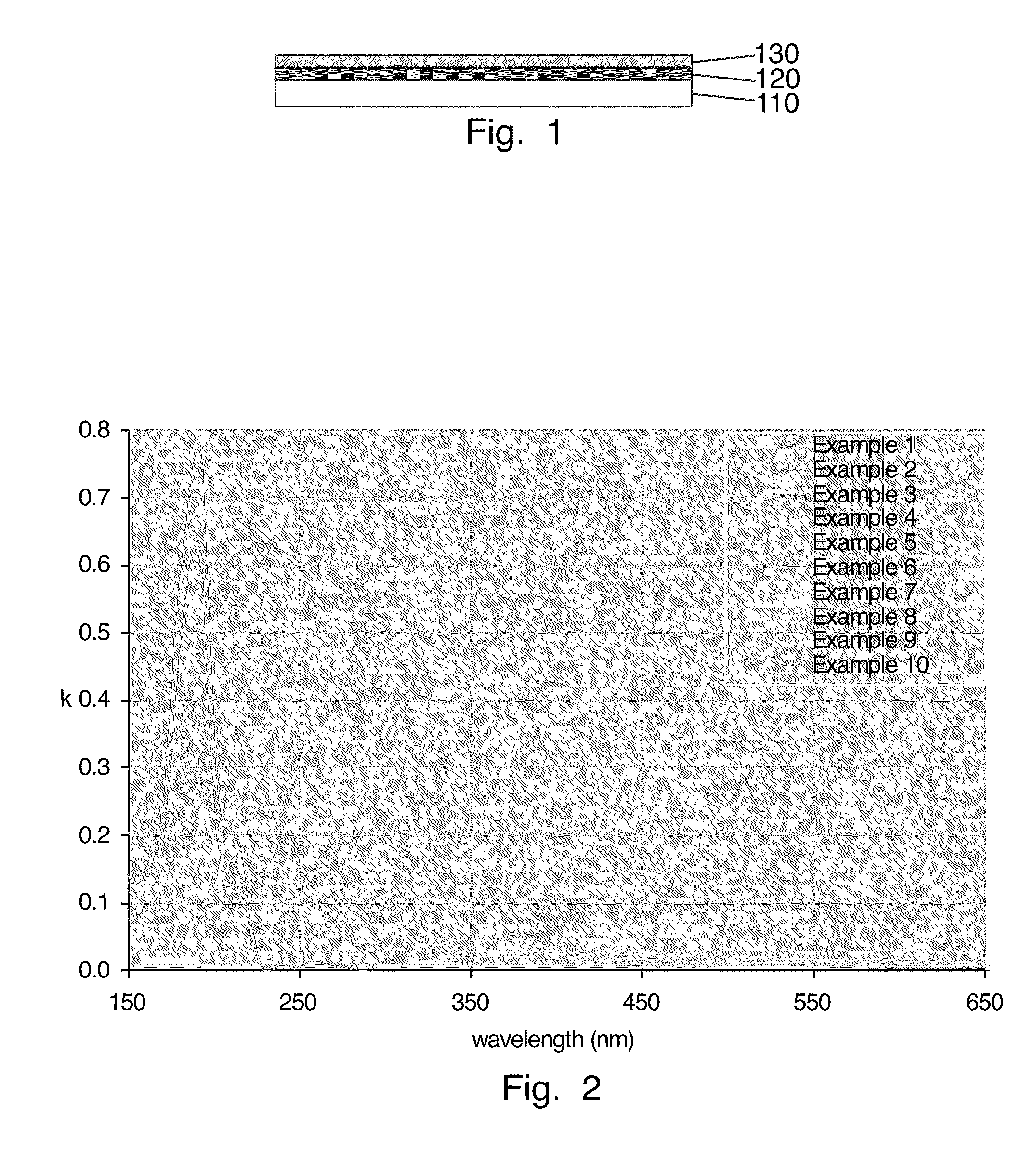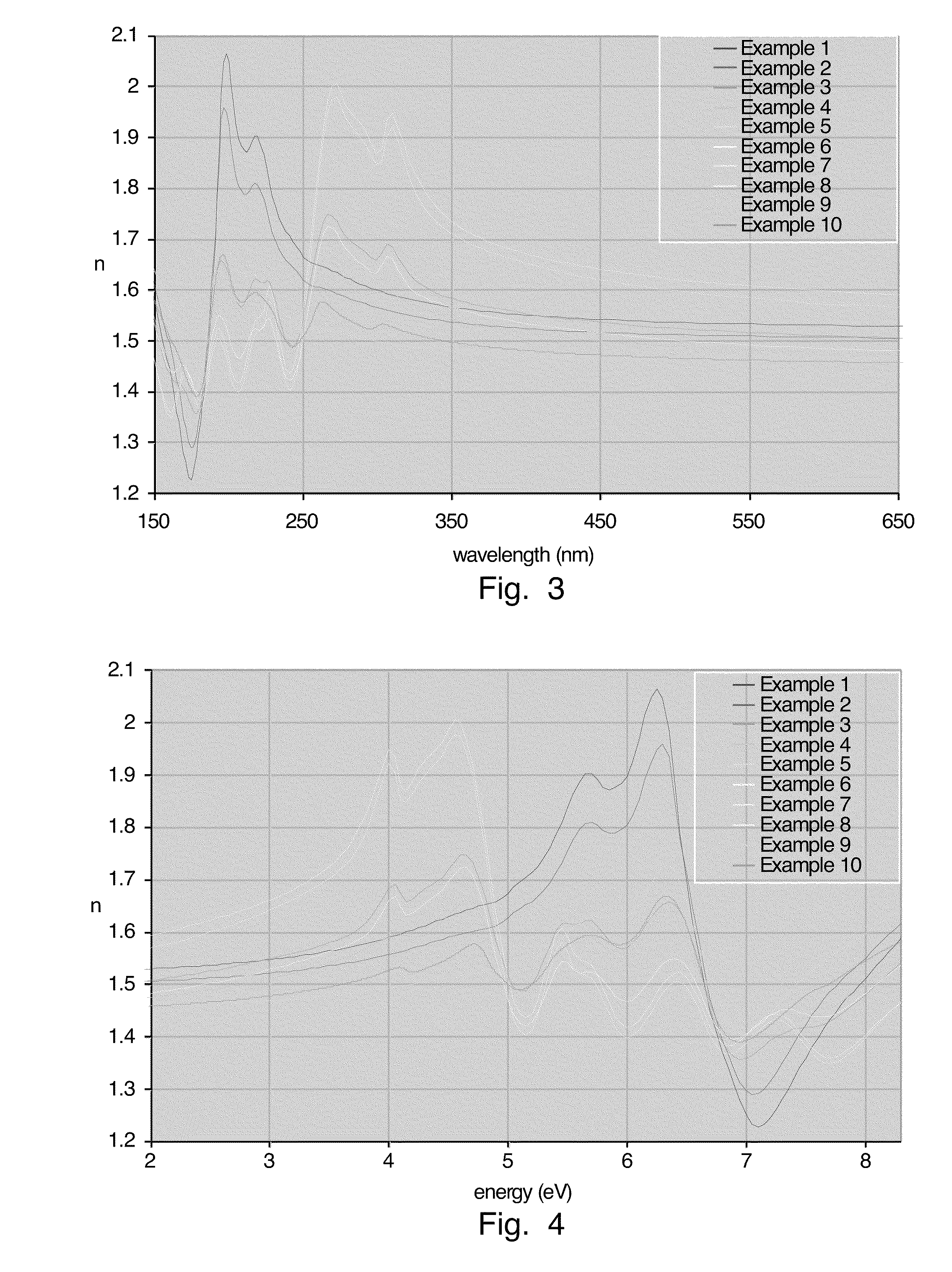Carbosilane polymer compositions for Anti-reflective coatings
a technology of anti-reflective coating and carbosilane, which is applied in the direction of anti-reflective coating, photomechanical equipment, instruments, etc., can solve the problems of off-normal reflection effect and standing wave effect, destructive interference of light passing through the arc, and create manufacturing process challenges, etc., to achieve good mechanical and thermal properties, and great tuning freedom
- Summary
- Abstract
- Description
- Claims
- Application Information
AI Technical Summary
Benefits of technology
Problems solved by technology
Method used
Image
Examples
example 1
[0146]Phenyltrimethoxysilane (14.04 g, 44 mol %), tetraethoxysilane (18.78 g, 56 mol %) were weighed to a round bottom flask. 65.64 g of acetone was added to the round bottom flask. 10.34 g of water (0.01 M HCl) was added to the reaction flask within 5 min, while constantly stirring the reaction mixture using a magnetic stirrer. After this the reaction mixture was stirred at RT for 27 min and refluxed for 5 hours using electric mantel. After the refluxing, most of the acetone was removed from the reaction mixture using a rotary evaporator (pressure 350->250 mbar, t(bath)=50° C.). After most of the acetone was removed, 72 g of PGMEA was added to the flask. The reaction mixture was evaporated further in the rotary evaporator (pressure 45 mbar, t(bath)=50° C., 1 hour) after PGMEA addition to perform a solvent exchange. After the solvent exchange the material solution was refluxed at 120° C. for 2 hours. After the 2 hour refluxing step the material is ready to use after dilution and fil...
example 2
[0148]Phenyltrimethoxysilane (9.57 g, 30 mol %), tetraethoxysilane (23.46 g, 70 mol %) were weighed to a round bottom flask. 66.06 g of acetone was added to the round bottom flask. 10.75 g of water (0.01 M HCl) was added to the reaction flask within 5 min, while constantly stirring the reaction mixture using a magnetic stirrer. After this the reaction mixture was stirred at RT for 27 min and refluxed for 5 hours using electric mantel. After the refluxing, most of the acetone was removed from the reaction mixture using a rotary evaporator (pressure 350->250 mbar, t(bath)=50 C). After most of the acetone was removed, 72.07 g of PGMEA was added to the flask. The reaction mixture was evaporated further in the rotary evaporator (pressure 45 mbar, t(bath)=50 C, 1 hour) after PGMEA addition to perform a solvent exchange. After the solvent exchange the material solution was refluxed at 120 C for 2 hours. After the 2 hour refluxing step the material is ready to use after dilution and filtrat...
example 3
[0149]Phenyltrimethoxysilane (4.78 g, 15 mol %), tetraethoxysilane (23.46 g, 70 mol %) and Phenanthrene-9-triethoxysilane (8.24 g, 15 mol %) were weighed to a round bottom flask. 72.96 g of acetone was added to the round bottom flask. 10.75 g of water (0.01 M HCl) was added to the reaction flask within 5 min, while constantly stirring the reaction mixture using a magnetic stirrer. After this the reaction mixture was stirred at RT for 28 min and refluxed for 5 hours using electric mantel. After the refluxing, most of the acetone was removed from the reaction mixture using a rotary evaporator (pressure 350->250 mbar, t(bath)=50° C.). After most of the acetone was removed, 72.18 g of PGMEA was added to the flask. The reaction mixture was kept further in the rotary evaporator (pressure 45 mbar, t(bath)=50° C., 1 hour) after PGMEA addition to perform a solvent exchange. After the solvent exchange the material solution was refluxed at 120 C for 2 hours. After the 2 hour refluxing step the...
PUM
| Property | Measurement | Unit |
|---|---|---|
| Temperature | aaaaa | aaaaa |
| Fraction | aaaaa | aaaaa |
| Fraction | aaaaa | aaaaa |
Abstract
Description
Claims
Application Information
 Login to View More
Login to View More - R&D
- Intellectual Property
- Life Sciences
- Materials
- Tech Scout
- Unparalleled Data Quality
- Higher Quality Content
- 60% Fewer Hallucinations
Browse by: Latest US Patents, China's latest patents, Technical Efficacy Thesaurus, Application Domain, Technology Topic, Popular Technical Reports.
© 2025 PatSnap. All rights reserved.Legal|Privacy policy|Modern Slavery Act Transparency Statement|Sitemap|About US| Contact US: help@patsnap.com



